-
Welcome to this forum . We are a worldwide group with a common interest in Birmingham and its history. While here, please follow a few simple rules. We ask that you respect other members, thank those who have helped you and please keep your contributions on-topic with the thread.
We do hope you enjoy your visit. BHF Admin Team
You are using an out of date browser. It may not display this or other websites correctly.
You should upgrade or use an alternative browser.
You should upgrade or use an alternative browser.
Birmingham 1969-73
- Thread starter mikejee
- Start date
The first two photographs were taken directly after the last two shots of the back of the houses in Jakeman Walk. They are back views of houses in the area. I do not think they are looking down the back of the houses on the west side of Cox St West, or further houses on the back of Jakeman Walk. It is possible that they are the back of the houses on the east side of Cox St West.
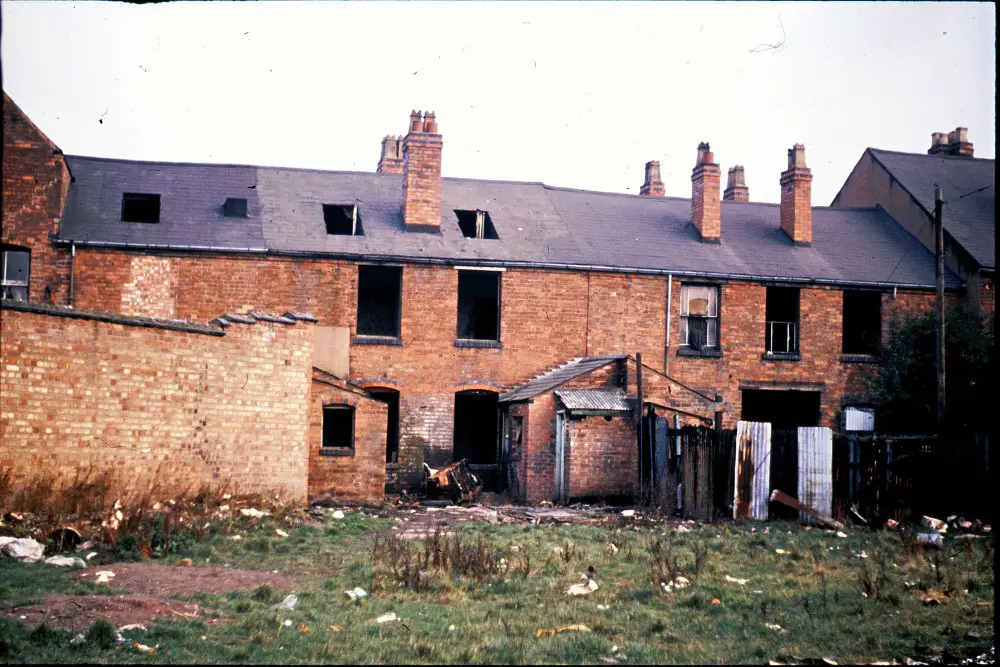
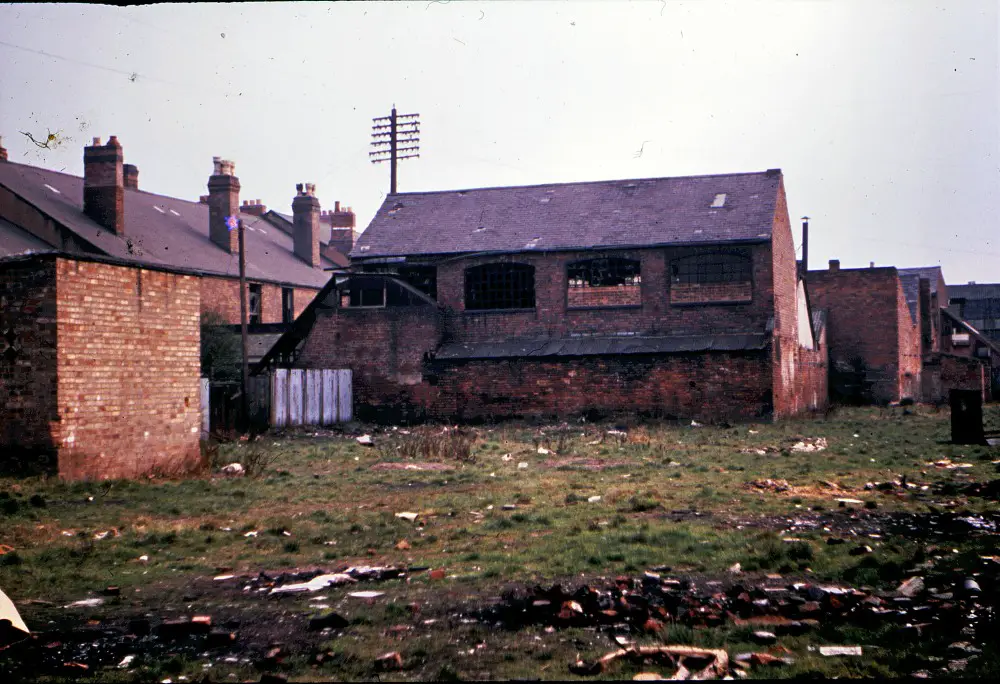
The third photo shows Orton's Industrial Finishes at no 92 and A.T.Mear, printers & stationers at 90-91. Ortons were enamellers, and had occupied the site for 35 years. Before them the building housed Cox & Co, japanners, who were there for 30 years. The first recorded use of the building was for about 15 years from 1876 as the home of a cab proprietor. At that time a large yard was beside and behind the building , known as Clevedon Mews.
Mear was there for a much shorter time from 1963. they were preceded by a capstan lathe works which existed from just before WW2, and before that by a wholesale grocers. The first use I can find for the building is of the base for a plumber & painter in 1888, a use which continued for 20 years. At the far left of the building can be seen a doored archway, which led to Prospect Place, though it is difficult to read the full name engraved in the stone unless you know it was there.
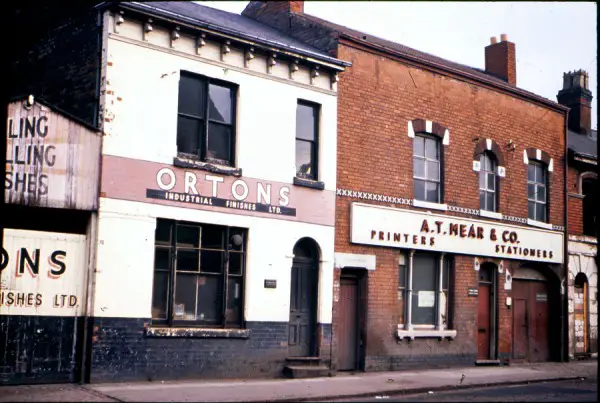
There is a slight discrepancy here in numbering in successive directories, but the final view shows towards the right the Aroma coffee house at no 86,, to the left of it Avotex textile merchants at no 87, with to the left of this two derelict buildings nos 88 and 89. At no 89 William Horton was a hairdresser from about 1909 there till 1962, though he still lived in the house in 1965. Between that and no 88 is an alleyway , above which is a plaque. this cannot easily be read , but indicates the entrance to St John's Place. Mrs Beatrice Potter ran a shop at 88 from the end of WW2 till about 1965, and before her another general shopkeeper occupied the building.
Avotex had only been at no 87 since 1967 From sometime in WW2 till then it seems to have been occupied by the Ward family, and before that Mark & Fanny Cohen and then Sid Teiger ran a tailoring business for about 20 years till about 1940. Before that it seems to have been a general shop.
Between Avotex and Aroma there is another archway. this led to Malvern Place, though the plaque above which would have indicated it has been removed. The Aroma similarly has only been there since about 1966. From about 1945 to 1962 Max Marks. tailor was there, though a large number of other people seem to be resident also. Before that a dyer occupied the house.
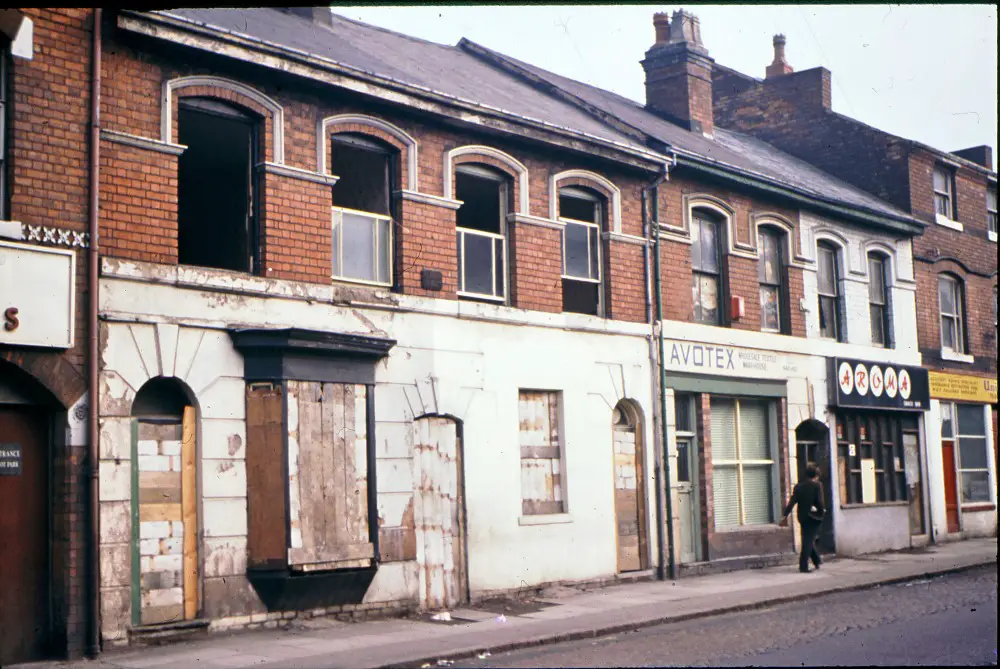


The third photo shows Orton's Industrial Finishes at no 92 and A.T.Mear, printers & stationers at 90-91. Ortons were enamellers, and had occupied the site for 35 years. Before them the building housed Cox & Co, japanners, who were there for 30 years. The first recorded use of the building was for about 15 years from 1876 as the home of a cab proprietor. At that time a large yard was beside and behind the building , known as Clevedon Mews.
Mear was there for a much shorter time from 1963. they were preceded by a capstan lathe works which existed from just before WW2, and before that by a wholesale grocers. The first use I can find for the building is of the base for a plumber & painter in 1888, a use which continued for 20 years. At the far left of the building can be seen a doored archway, which led to Prospect Place, though it is difficult to read the full name engraved in the stone unless you know it was there.

There is a slight discrepancy here in numbering in successive directories, but the final view shows towards the right the Aroma coffee house at no 86,, to the left of it Avotex textile merchants at no 87, with to the left of this two derelict buildings nos 88 and 89. At no 89 William Horton was a hairdresser from about 1909 there till 1962, though he still lived in the house in 1965. Between that and no 88 is an alleyway , above which is a plaque. this cannot easily be read , but indicates the entrance to St John's Place. Mrs Beatrice Potter ran a shop at 88 from the end of WW2 till about 1965, and before her another general shopkeeper occupied the building.
Avotex had only been at no 87 since 1967 From sometime in WW2 till then it seems to have been occupied by the Ward family, and before that Mark & Fanny Cohen and then Sid Teiger ran a tailoring business for about 20 years till about 1940. Before that it seems to have been a general shop.
Between Avotex and Aroma there is another archway. this led to Malvern Place, though the plaque above which would have indicated it has been removed. The Aroma similarly has only been there since about 1966. From about 1945 to 1962 Max Marks. tailor was there, though a large number of other people seem to be resident also. Before that a dyer occupied the house.

Viewfinder
master brummie
absolutely fantastic mike...pic 1 post 88 those lads are posing for you lol and like viewfinder i find the shadowy figure of someone walking up the entry very atmospheric...without you and your camera these images would have been lost in time...in fact i will go so far as to say that you carried on where phyllis nicklin left off
thanks mike
lyn
You and I will gang up on Mike to persuade him to publish a book of his deeply atmospheric photos of Brum in the early 1970s. It would be a sure-fire winner.
You and I will gang up on Mike to persuade him to publish a book of his deeply atmospheric photos of Brum in the early 1970s. It would be a sure-fire winner.
totally agree with you viewfinder they are wonderful images of days gone by and evoke so many memories for us..
Next along are buildings 88 -85. No 84/85 (the number varies) was being partly seen in the last picture. The firm United Autos would presumably be the trade name of G.H. Yule & Co , motor engineers., who had been there since the late 1940s, immediately preceded for 10 years by another motor engineer, and before that by a taxi cab firm.
Nos 81-83 are here occupied by H.E Breaker (Metalwork) Ltd, architectural metal workers., who have been here since the early 1950s. Before that nos 81-82 was the mineral water factory of J.H.Jones., who came her sometime between 1924 and 1932 from Milk St.Before that all had been a builders , under different names for about 25 years, and part a builders for another 15s years. the other part was the drill hall and headquarters E & F batteries of the 1st Worcestershire Artillery volunteers
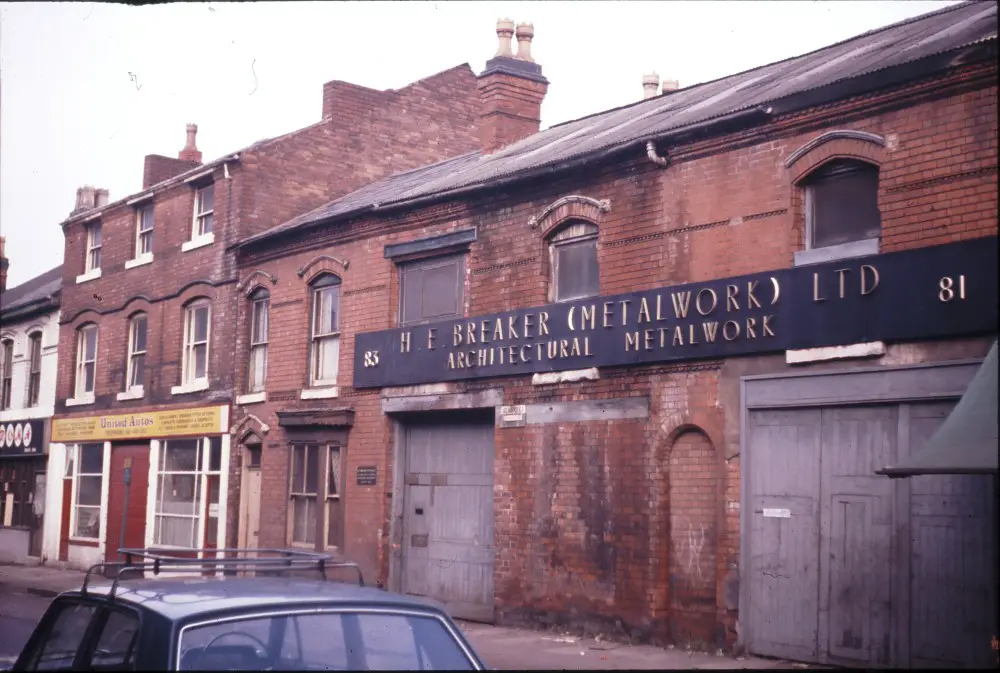
Nos 81-83 are here occupied by H.E Breaker (Metalwork) Ltd, architectural metal workers., who have been here since the early 1950s. Before that nos 81-82 was the mineral water factory of J.H.Jones., who came her sometime between 1924 and 1932 from Milk St.Before that all had been a builders , under different names for about 25 years, and part a builders for another 15s years. the other part was the drill hall and headquarters E & F batteries of the 1st Worcestershire Artillery volunteers

Last edited:
Nos 78,79 & 80a 90 Cox St West are shown here. The small shop on the left (80a) is described in Kellys as a minimarket. it has been some form of grocer for at least 5 years, there has been some reconstruction around the building, and lack of other entries suggests it may previously have been considered part of the buildings either side of it. no 79 in the centre had been a tailors from about 1960 till 1968. All three buildings from WW2 up till late 1950s had been owned by Deakins Bros, described as either provision dealers or fruiterers and green grocers. the business presumably originated in Archbald Bert Deakin, who from mid 1930s till 1940 was at no 79 , described as bird dealer. These buildings served a number of purposes, and no 79 from about 1880 was , for over 40 years, an offlicence
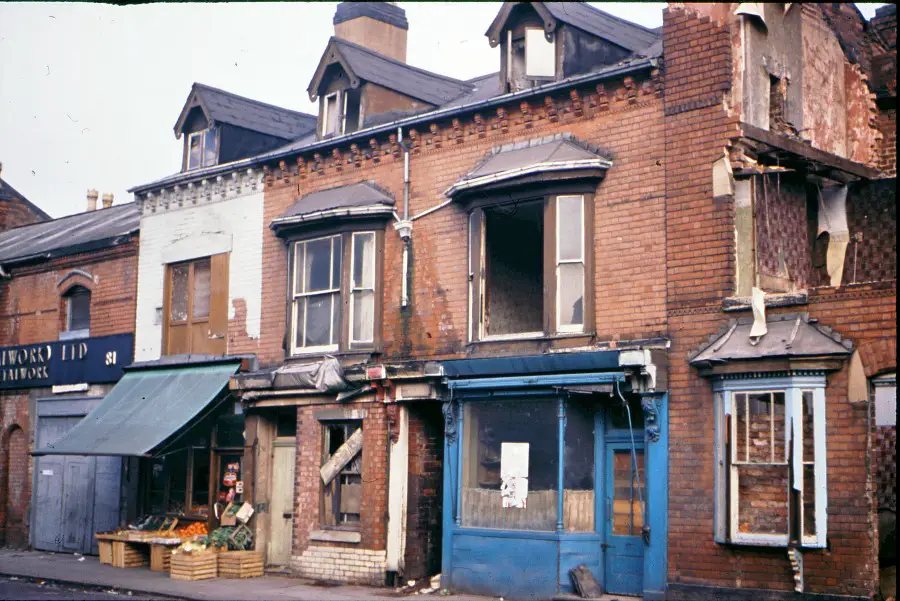

Viewfinder
master brummie
what a great photo mike...half demolished buidings all around but that little veg shop is determined to carry on to the bitter end...
lyn
Note also the half-demolished house on the right: the bricked-up window on the ground floor and, ironically and poignantly, the flapping wallpaper of a brick-like design above. This is another superb photograph for Mike's book.
To me the other striking thing about partially demolished buildings is all the different little features that were painstakingly put together by those craftsmen over a century ago. So much was crafted and, even in a row of similar terrace houses, small features were added to make slight differences between them.
And you can still see the shelving inside the 'blue' shop. The shop front fascia has lovely scrolled supports and the vertical window bars have small details too.The shopkeeper must once have been very proud to run his/her business from here and would have been a well-known and respected member of the local community. I expect many aspiring shopkeepers who started out running a shop from their front room would aim to one day own a little business like this. But it required very hard graft too. Viv.
And you can still see the shelving inside the 'blue' shop. The shop front fascia has lovely scrolled supports and the vertical window bars have small details too.The shopkeeper must once have been very proud to run his/her business from here and would have been a well-known and respected member of the local community. I expect many aspiring shopkeepers who started out running a shop from their front room would aim to one day own a little business like this. But it required very hard graft too. Viv.
Viewfinder
master brummie
To me the other striking thing about partially demolished buildings is all the different little features that were painstakingly put together by those craftsmen over a century ago. So much was crafted and, even in a row of similar terrace houses, small features were added to make slight differences between them.
And you can still see the shelving inside the 'blue' shop. The shop front fascia has lovely scrolled supports and the vertical window bars have small details too.The shopkeeper must once have been very proud to run his/her business from here and would have been a well-known and respected member of the local community. I expect many aspiring shopkeepers who started out running a shop from their front room would aim to one day own a little business like this. But it required very hard graft too. Viv.
Nicely put, Viv. I hadn't noticed the details you mention, to which can be added the decorative brickwork under the eaves and even the simple A-frame bargeboards above the attic windows.
I notice too, the then modern window ads in the veg shop for Birds Eye and Pepsi. Its as if the owners were determined were determined to persevere into the next decade, regardless of what was happening.
My late dad in Wolverhampton had a chemist shop in exactly the same circumstances(1962). Regardless of the town plan for the 'new sixties' having been published which meant demo of his shop's street and the local area, he still had a loyalty to his customers promising them with Max Factor adverts and the like that his service was just as good as the new supermarkets.
My late dad in Wolverhampton had a chemist shop in exactly the same circumstances(1962). Regardless of the town plan for the 'new sixties' having been published which meant demo of his shop's street and the local area, he still had a loyalty to his customers promising them with Max Factor adverts and the like that his service was just as good as the new supermarkets.
The next four shots show in, succession, the houses nos 68-74, 66-69, 61-66 and finally the whole row, though in the last shot the larger numbered houses are not very clearly shown.
No 74 is actually being demolished. In the last 80 years of its life it seems to have been just a domestic house, though it is recorded as a general shop in the 1880s.
No 73 was a pawnbrokers from the early 1870s till around WW1, but then also was just domestic housing.
No 72 was a ladies hairdressers in the 1960s, but from the mid 1930s till the late 1950s was occupied by a saddler, Robert Shelton, and previously from about 1890 by another saddler, Joseph Lomas. Previous to that it had been a butchers. a hardware dealers and a greengrocers.
No 71 had a wide range of occupants, watch & clock dealer, cabinet maker , Mac Motors (whatever they may be), but mostly general shopkeeper. For a few years at the end of WW1 no 70 was the home of James Davies , bird dealer, and before that was a general shop, haberdasher, and for over 12 years from 1880, a staymaker (John Cartledge). For the benefit of Eastenders fans, in 1879 it was the home of greengrocer Arthur Woodyatt. (for non-fans Adam Woodyatt plays Ian Beale fruit & veg stallholder).
No 69 seems to have been largely non-commercial, though has been occupied by a wood-turner and a sign writer.
No 68 again was largely just residential.
No 67 was lastly a secondhand clothes shop and previously for 10 years a tailoress, with previous occupants being a general shopkeeper, hardware, dealer, newsagent, and painter & decorator.
No 66 was initially a haberdashers, then a general shop for some years, but around 1910 the site was taken over by the Gunn family, initially by Thomas Gunn as a tripe shop, which was carried on by Sarah Gunn. However in the late 1920s, perhaps because of a lack of demand for tripe, she changed to a drapers, which did not last long and from the early 1930s until WW2 it was a printers, latterly The Calthorpe Press.
No 66 was a general shop for much of its life, though a newsagent for a while in the 1880s and a drapers at the end of WW1, but after the early 1930s seems to be residential.
64 was residential for most of its life except for a period in the 1880s as a general shop and in the 1920s when it was occupied by a laundress.
No 63 was a tobacconist and then a boot repairers in the 1870s, and then a general shop till around 1910, when it was briefly a fried fish shop, then a secondhand cloths shop for a year or so.
No 62 George Pettitt was a shoe & boot repairer here from 1881 till about 1932, when Miss Kate Pettitt took over the shop , who was at first just described as a shopkeeper, but then from about 1942 till about 1956 as a grindery dealer, which I gather means she sold the tools and equipment of shoemakers and leatherworkers.
Finally no 61 was the off license. The first licensee was probably Henry James Gardner Riome, ale and porter dealer from around 1876 . He was only there for a few years, and was followed by a succession of other licensees .
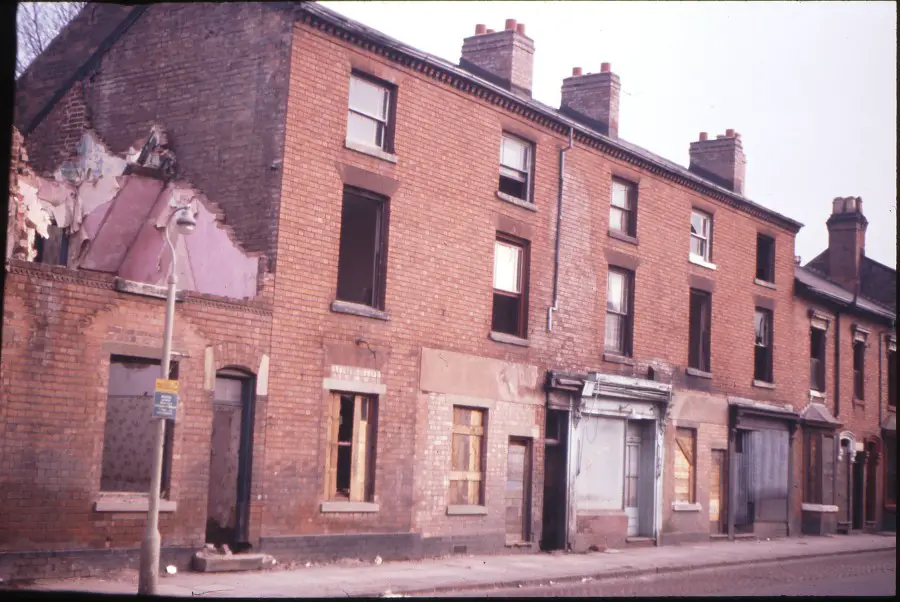
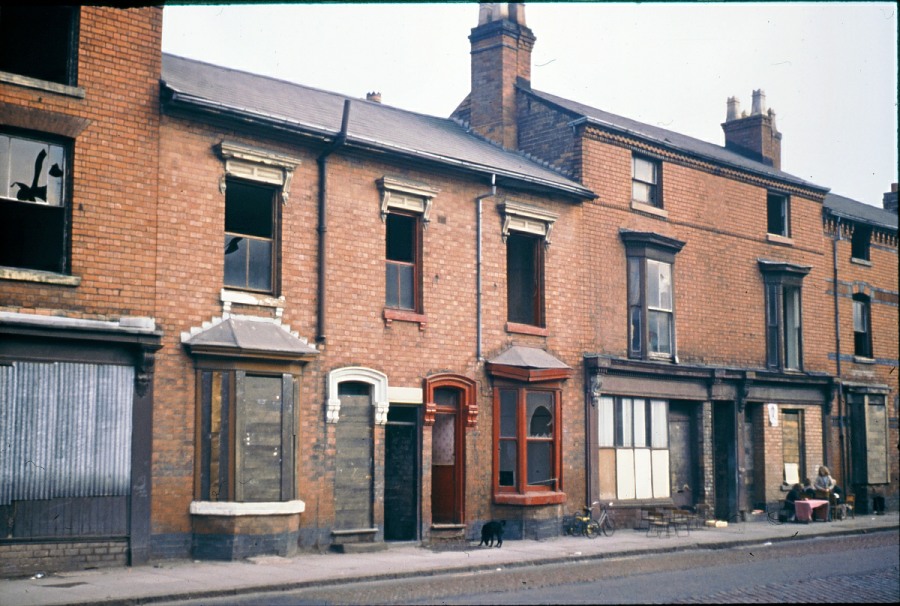
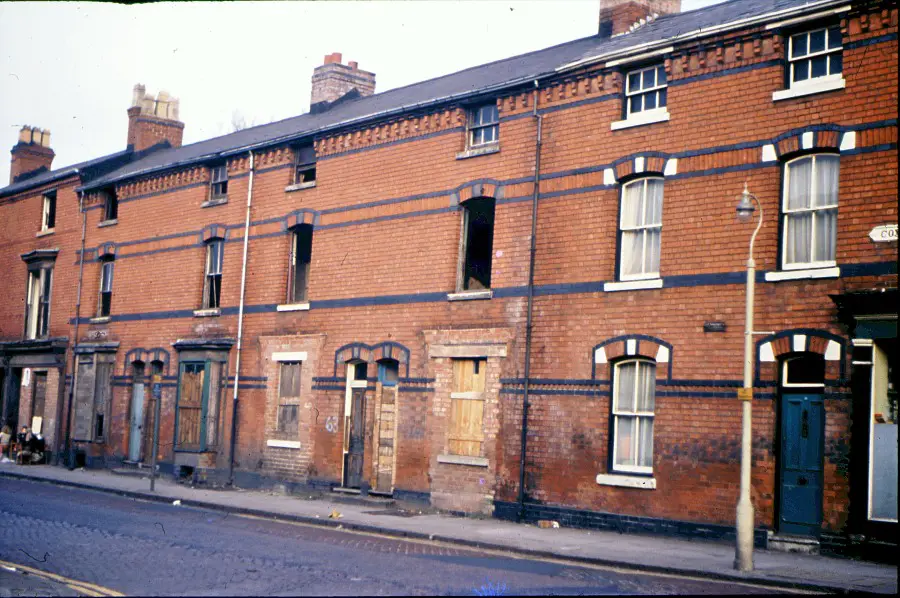
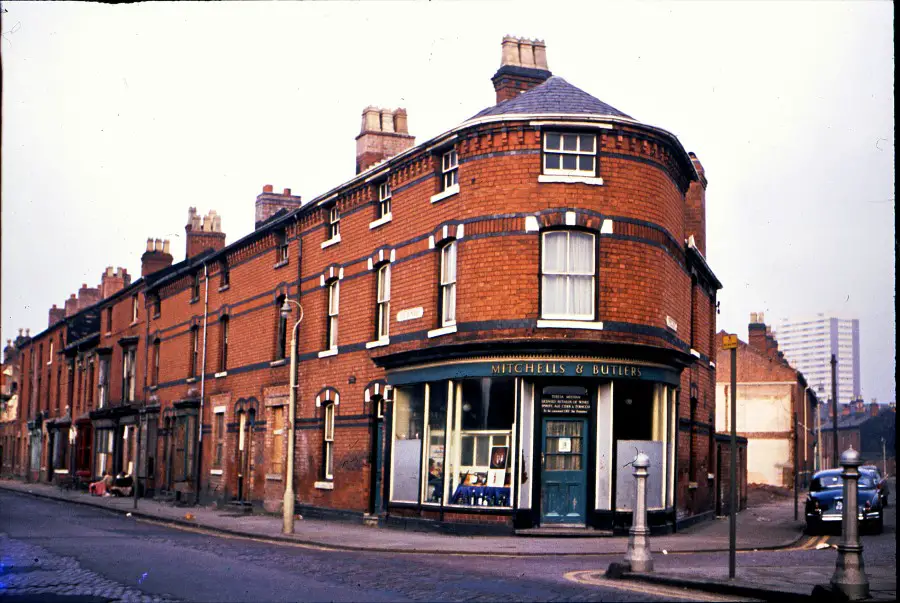
No 74 is actually being demolished. In the last 80 years of its life it seems to have been just a domestic house, though it is recorded as a general shop in the 1880s.
No 73 was a pawnbrokers from the early 1870s till around WW1, but then also was just domestic housing.
No 72 was a ladies hairdressers in the 1960s, but from the mid 1930s till the late 1950s was occupied by a saddler, Robert Shelton, and previously from about 1890 by another saddler, Joseph Lomas. Previous to that it had been a butchers. a hardware dealers and a greengrocers.
No 71 had a wide range of occupants, watch & clock dealer, cabinet maker , Mac Motors (whatever they may be), but mostly general shopkeeper. For a few years at the end of WW1 no 70 was the home of James Davies , bird dealer, and before that was a general shop, haberdasher, and for over 12 years from 1880, a staymaker (John Cartledge). For the benefit of Eastenders fans, in 1879 it was the home of greengrocer Arthur Woodyatt. (for non-fans Adam Woodyatt plays Ian Beale fruit & veg stallholder).
No 69 seems to have been largely non-commercial, though has been occupied by a wood-turner and a sign writer.
No 68 again was largely just residential.
No 67 was lastly a secondhand clothes shop and previously for 10 years a tailoress, with previous occupants being a general shopkeeper, hardware, dealer, newsagent, and painter & decorator.
No 66 was initially a haberdashers, then a general shop for some years, but around 1910 the site was taken over by the Gunn family, initially by Thomas Gunn as a tripe shop, which was carried on by Sarah Gunn. However in the late 1920s, perhaps because of a lack of demand for tripe, she changed to a drapers, which did not last long and from the early 1930s until WW2 it was a printers, latterly The Calthorpe Press.
No 66 was a general shop for much of its life, though a newsagent for a while in the 1880s and a drapers at the end of WW1, but after the early 1930s seems to be residential.
64 was residential for most of its life except for a period in the 1880s as a general shop and in the 1920s when it was occupied by a laundress.
No 63 was a tobacconist and then a boot repairers in the 1870s, and then a general shop till around 1910, when it was briefly a fried fish shop, then a secondhand cloths shop for a year or so.
No 62 George Pettitt was a shoe & boot repairer here from 1881 till about 1932, when Miss Kate Pettitt took over the shop , who was at first just described as a shopkeeper, but then from about 1942 till about 1956 as a grindery dealer, which I gather means she sold the tools and equipment of shoemakers and leatherworkers.
Finally no 61 was the off license. The first licensee was probably Henry James Gardner Riome, ale and porter dealer from around 1876 . He was only there for a few years, and was followed by a succession of other licensees .




Last edited:
oldMohawk
gone but not forgotten
It is interesting how they used different coloured bricks particularly in arches over windows and doors, and also the use of the blue bricks to good effect. The two metal bollards in front of the off-licence are impressive and they protected them with those stone lumps on the kerbs which I've often noticed in old street photos.
Viewfinder
master brummie
Exactly as Viv and Richie spotted shelves and remnants in the previous grocer's, look at this marvellous window display - the M & B offie on the corner. The bottles are arranged precisely against a blue cloth. Deep blue was alluring in those days of uniform red brick. It hints at the Cote d'Azur: if not Raoul Dufy then Worthing makes a change from Skegness. Windows within windows: the curved glass above is lovely. And the curtained door: No Entry. Mike has got it again: the figures sitting on the pavement left of frame - and the car and flats to the right.
These three shots run together. To the left of the off license is the junction with Upper Cox St. The houses in the terrace here are 41 then 40 Upper Cox St, then, separated by an entry, 60 - 56 Cox St West, with part of 55 showing on the second shot and 55 on the left of the third shot, which also has nos 54-51. The set-back house to the left of 41 would be the end of Morley Place. Both of the houses in Upper Cox St, and nos 60-56 Cox St West seem to have always been purely residential. No 55 started as a tobacconists, but from the late 1880s was a coal dealers. around the mid 1890s there was both a coal dealers at 55A (presumably the entry with the gate), and also a shop. The coal dealers disappeared at the start of WW1, though 55A continued for some years , being used successively as a plumbers, joiners and decorators yard, while the main general shop/tobacconist continued till the early 1970s.
No 54 from the mid 1880s till the early 1930s was an umbrella makers, though with several different owners. For a few years around 1960 it was a hairdressers. In the photo there seems to be a board, possibly with foreign script on it, but at this time the property is not listed in Kellys.
No 53 was a butchers in the 1880s and in the 1890s a tailors. From about 1911 till about 1930 it was combined with no 52 as William Alibone, confectioners, but by 1932 no 52 was run as a confectioners by Mrs Caroline Sealey, while no 53 was an antique dealers run by Mr George Sealey. Caroline did not last very long and sold out after a couple of years, but George's "antiques" lasted till 1970. Pre-1910 no 52nhad been a milk dealers for 25 years.
No 51 had been an eating house from the early 1900s till the mid 1930s, and before that a general shop for some years.
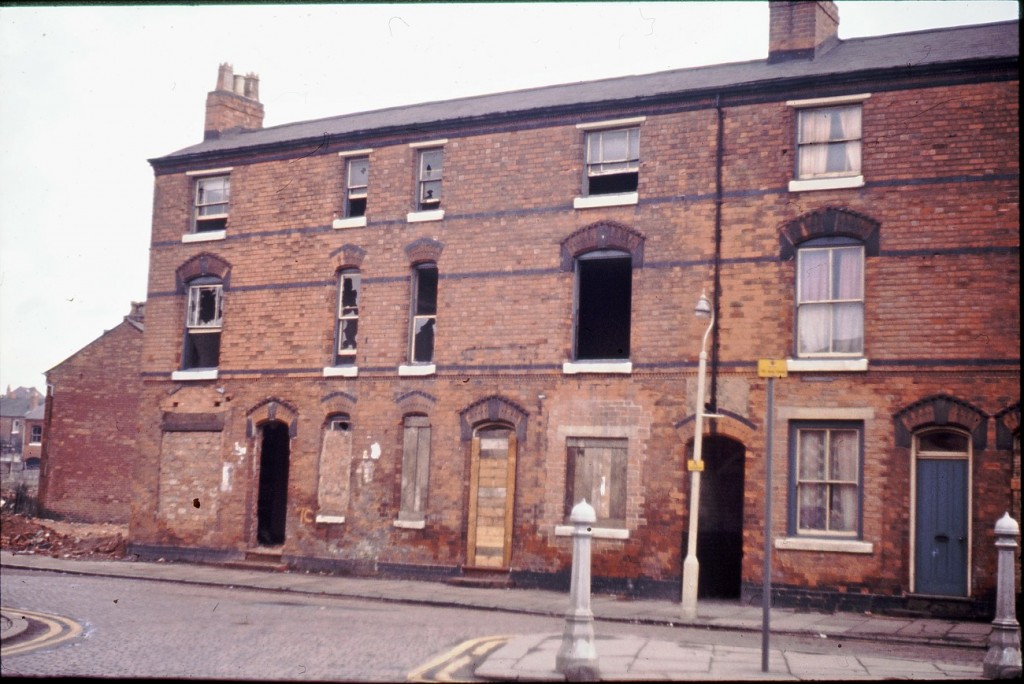
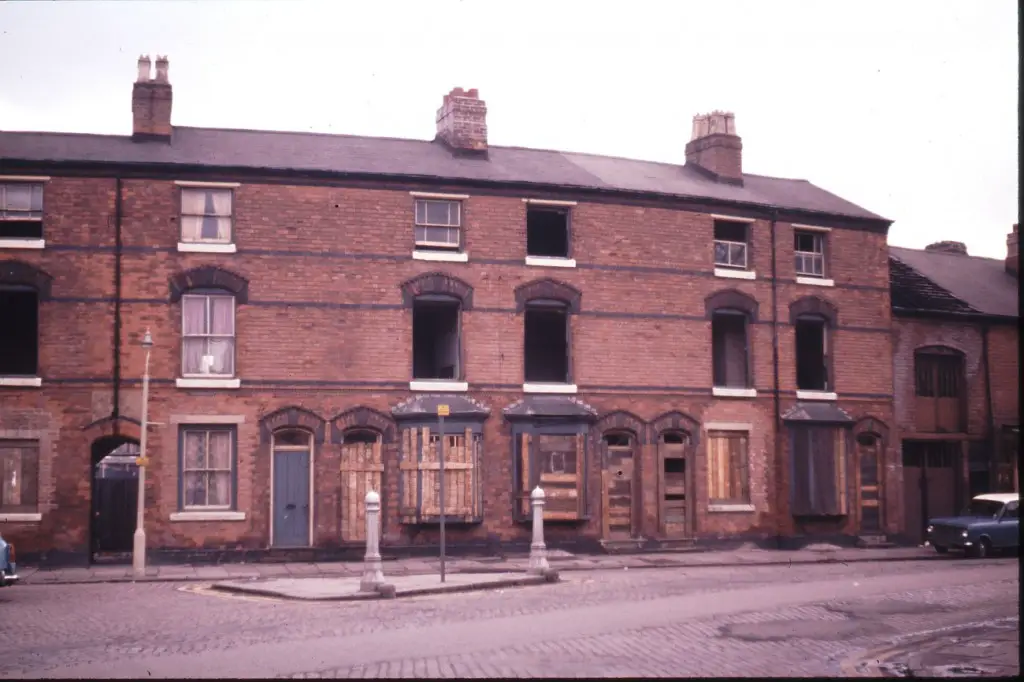
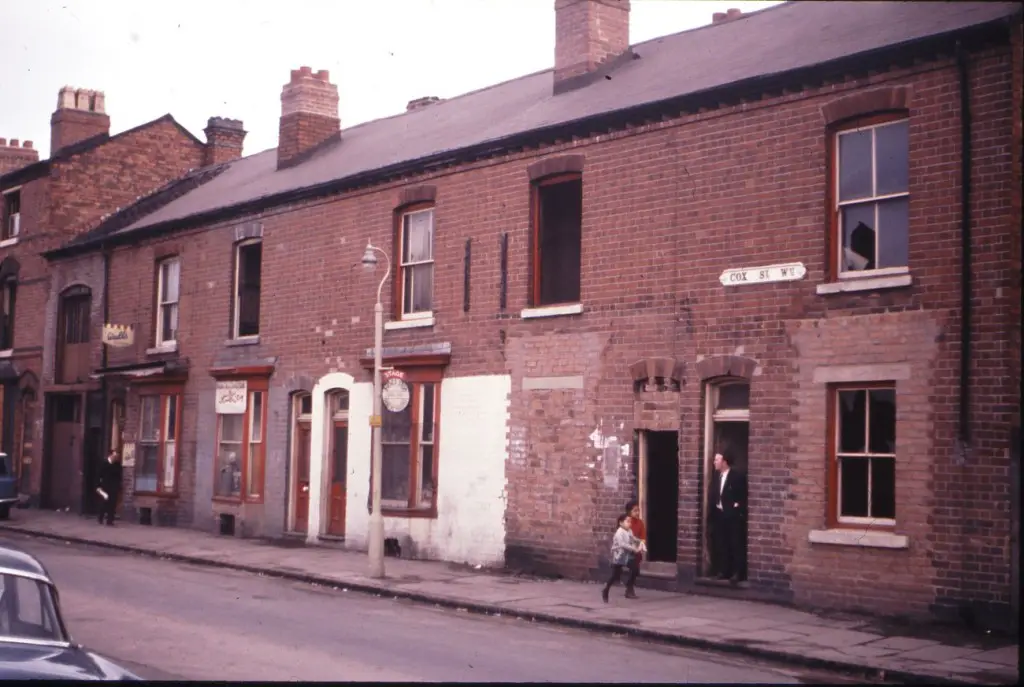
No 54 from the mid 1880s till the early 1930s was an umbrella makers, though with several different owners. For a few years around 1960 it was a hairdressers. In the photo there seems to be a board, possibly with foreign script on it, but at this time the property is not listed in Kellys.
No 53 was a butchers in the 1880s and in the 1890s a tailors. From about 1911 till about 1930 it was combined with no 52 as William Alibone, confectioners, but by 1932 no 52 was run as a confectioners by Mrs Caroline Sealey, while no 53 was an antique dealers run by Mr George Sealey. Caroline did not last very long and sold out after a couple of years, but George's "antiques" lasted till 1970. Pre-1910 no 52nhad been a milk dealers for 25 years.
No 51 had been an eating house from the early 1900s till the mid 1930s, and before that a general shop for some years.



Viewfinder
master brummie
they just get better and better mike and all the extra info provided is a bonus...
lyn
I agree entirely, Lyn. Isn't that beautiful and poignant: man in smart suit, white shirt and tie, looking expectantly - poised on the step of a derelict house. Mike's previous photos are also superb: look at the first one, the house on the left: anthropomorphic doorway as mouth agape in horror, and shattered windows like eyes of a shrieking devil. These are wonderful photographs.
I agree entirely, Lyn. Isn't that beautiful and poignant: man in smart suit, white shirt and tie, looking expectantly - poised on the step of a derelict house. Mike's previous photos are also superb: look at the first one, the house on the left: anthropomorphic doorway as mouth agape in horror, and shattered windows like eyes of a shrieking devil. These are wonderful photographs.
quite right to get excited about these photos of mikes viewfinder...absolutely wonderful..doubt very much we will ever see the likes of them again...
lyn
Old Boy
master brummie
Viewfinder;: anthropomorphic doorway as mouth agape in horror said:Viewfinder,
Greetings but, come off it, what does anthropomorphic mean ? Or do I have to buy a dictionary.
All the best = Old Boy
Viewfinder
master brummie
Viewfinder,
Greetings but, come off it, what does anthropomorphic mean ? Or do I have to buy a dictionary.
All the best = Old Boy
Really, Old Boy, your slip is showing! Anthropomorphic refers to inanimate objects having human-like features.
Photo on Number 108 is even more of a stunner. As we say, the well-dressed man at the family(?) home waiting for a taxi. Not a bus as there's a bus stop on the pavement right outside there. Or maybe he's apprehensive about going out for the day hence the door not closed yet.
Then there's the two Asian children skipping past. Too young to know about life's cares whichever country, but Birmingham will do; and as we older West Midlanders know very well indeed whatever community.
The hanging Wall's Ice Cream signs. Maybe put up following instructions from the manufacturer, but looking somewhat forelorn. Not in defiance of the future as in earlier posts, but maybe in resignation.
The glimpse of the car in the bottom left hand corner. Ford certainly, Consul?. Seems very well preserved but really you know, just looked after. Like us, really, by our parents those many years ago, in the face of uncertainty.
we don't have to go to art exhibitions in New York for excellence. Mike's captures are,our own, Birmingham photograph jewels.
Richie.
Then there's the two Asian children skipping past. Too young to know about life's cares whichever country, but Birmingham will do; and as we older West Midlanders know very well indeed whatever community.
The hanging Wall's Ice Cream signs. Maybe put up following instructions from the manufacturer, but looking somewhat forelorn. Not in defiance of the future as in earlier posts, but maybe in resignation.
The glimpse of the car in the bottom left hand corner. Ford certainly, Consul?. Seems very well preserved but really you know, just looked after. Like us, really, by our parents those many years ago, in the face of uncertainty.
we don't have to go to art exhibitions in New York for excellence. Mike's captures are,our own, Birmingham photograph jewels.
Richie.
Viewfinder
master brummie
Wonderful observations, Richie. I wondered if the well-dressed gent on the threshold of the ruined house could be waiting for a lady of the night; certainly similar streets in Balsall Heath have been used for prostitution. But then it dawned that she would be the one waiting, and he would be in a car.
I think the best of Mike's photos, this one included, transcend merely local interest and possess universal qualities. The same goes for Phyllis Nicklin's pictures from a decade or so earlier; some of her scenes are no more than historical records yet the best have a painterly quality reminiscent of Lowry.
I feel certain that Mike's and Phyllis's pictures would make a splendid book; this subject is increasingly popular, exemplified by Shirley Baker's photos of street life in Salford in the 1960s, to be exhibited at The Photographers' Gallery here in London in the autumn. As a working photographer I have self-published my own monograph and could help with editing and design.
I think the best of Mike's photos, this one included, transcend merely local interest and possess universal qualities. The same goes for Phyllis Nicklin's pictures from a decade or so earlier; some of her scenes are no more than historical records yet the best have a painterly quality reminiscent of Lowry.
I feel certain that Mike's and Phyllis's pictures would make a splendid book; this subject is increasingly popular, exemplified by Shirley Baker's photos of street life in Salford in the 1960s, to be exhibited at The Photographers' Gallery here in London in the autumn. As a working photographer I have self-published my own monograph and could help with editing and design.
message from carl chinn
mike i hope you dont mind but a few days ago i took the liberty of alerting carl chinn to what i can only describe as i have done many times as a wonderful piece of brum history..for a long time now myself and others have always thought that you deserve recognition for the way you have through your photos brought the past back to those of us who thrive of the history of birmingham..he has spent time reading this thread and this was his reply to me today...he has also asked me to tell you that he would be very happy to include some of your photos in a major article of his brummagem magazine...i will talk to you privately and connect you with carl if you feel this is something you would like to do..i have posted this on the forum as its only right that both yourself and our members can see how important carl thinks your work is and i am not going to argue with him..we are all very grateful to you...this is his reply..
Thanks Lyn
This is a most rare and most important photographic record of a city in the
throes of destruction and change. Each picture is compelling and
thought-provoking.
Mike should really put an exhibition of his work at somewhere like the
Library of Birmingham. His memories of the photos and the added
interpretations would make a fascinating written account of a superb
pictorial record.
Best wishes
Carl
mike i hope you dont mind but a few days ago i took the liberty of alerting carl chinn to what i can only describe as i have done many times as a wonderful piece of brum history..for a long time now myself and others have always thought that you deserve recognition for the way you have through your photos brought the past back to those of us who thrive of the history of birmingham..he has spent time reading this thread and this was his reply to me today...he has also asked me to tell you that he would be very happy to include some of your photos in a major article of his brummagem magazine...i will talk to you privately and connect you with carl if you feel this is something you would like to do..i have posted this on the forum as its only right that both yourself and our members can see how important carl thinks your work is and i am not going to argue with him..we are all very grateful to you...this is his reply..
Thanks Lyn
This is a most rare and most important photographic record of a city in the
throes of destruction and change. Each picture is compelling and
thought-provoking.
Mike should really put an exhibition of his work at somewhere like the
Library of Birmingham. His memories of the photos and the added
interpretations would make a fascinating written account of a superb
pictorial record.
Best wishes
Carl
Last edited:
ok mike will chat when you get back...i really do think its wonderful that a bhf member has been praised so highly by carl chinn who does recognise the historical importance of your work ....i think what we have to remember is its not everyday that unique photographs like yours come along and you have been only to happy to share them with us and they can not be under estimated...thanks again mike
lyn
lyn
Last edited:
Well deserved Mike. I totally agree with Carl's comments. You've added such a lot to the history of Birmingham through your photos. All the research too that goes with the photos is a very valuable record and resource. So an exhibition would be fantastic. (No pressure!) I think we'd all love to see that happen.
And I've so enjoyed the unknown photos thread too. It really makes a person look at the tiny details in a photo, little hints that will hopefully give clues. Gets people involved. Viv.
And I've so enjoyed the unknown photos thread too. It really makes a person look at the tiny details in a photo, little hints that will hopefully give clues. Gets people involved. Viv.

